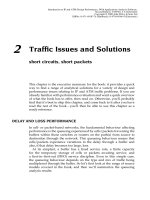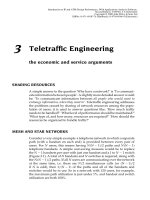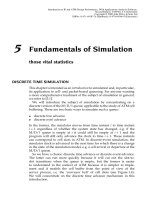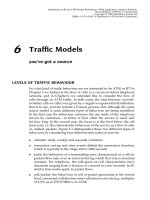Tài liệu Giới thiệu về IP và ATM - Thiết kế và hiệu suất P1 ppt
Bạn đang xem bản rút gọn của tài liệu. Xem và tải ngay bản đầy đủ của tài liệu tại đây (92.19 KB, 13 trang )
PART I
Introductory Topics
Introduction to IP and ATM Design Performance: With Applications Analysis Software,
Second Edition. J M Pitts, J A Schormans
Copyright © 2000 John Wiley & Sons Ltd
ISBNs: 0-471-49187-X (Hardback); 0-470-84166-4 (Electronic)
1
An Introduction
to the Technologies of IP
and ATM
the bare necessities
This chapter is intended as a brief introduction to the technologies of
the Asynchronous Transfer Mode (ATM) and the Internet Protocol (IP)
on the assumption that you will need some background information
before proceeding to the chapters on traffic engineering and design. If
you already have a good working knowledge you may wish to skip this
chapter, because we highlight the fundamental operation as it relates to
performance issues rather than describe the technologies and standards
in detail. For anyone wanting a deeper insight we refer to [1.1] for
a comprehensive introduction to the narrowband Integrated Services
Digital Network (ISDN), to [1.2] for a general introduction to ATM
(including its implications for interworking and evolution) and to [1.3]
for next-generation IP.
CIRCUIT SWITCHING
In traditional analogue circuit switching, a call is set-up on the basis that
it receives a path (from source to destination) that is its ‘property’ for
the duration of the call, i.e. the whole of the bandwidth of the circuit
is available to the calling parties for the whole of the call. In a digital
circuit-switched system, the whole bit-rate of the line is assigned to a
call for only a single time slot per frame. This is called ‘time division
multiplexing’.
During the time period of a frame, the transmitting party will generate
a fixed number of bits of digital data (for example, 8 bits to represent
Introduction to IP and ATM Design Performance: With Applications Analysis Software,
Second Edition. J M Pitts, J A Schormans
Copyright © 2000 John Wiley & Sons Ltd
ISBNs: 0-471-49187-X (Hardback); 0-470-84166-4 (Electronic)
4
AN INTRODUCTION TO THE TECHNOLOGIES OF IP AND ATM
the level of an analogue telephony signal) and these bits will be grouped
together in the time slot allocated to that call. On a transmission link, the
same time slot in every frame is assigned to a call for the duration of that
call (Figure 1.1). So the time slot is identified by its position in the frame,
hence use of the name ‘position multiplexing’, although this term is not
used as much as ‘time division multiplexing’.
When a connection is set up, a route is found through the network and
that route remains fixed for the duration of the connection. The route will
probably traverse a number of switching nodes and require the use of
many transmission links to provide a circuit from source to destination.
The time slot position used by a call is likely to be different on each link.
The switches which interconnect the transmission links perform the time
slot interchange (as well as the space switching) necessary to provide
the ‘through-connection’ (e.g. link M, time slot 2 switches to link N, time
slot 7 in Figure 1.2).
0 1 2 3 4 5 6 7
0 1 2 3 4 5 6 7
Duration of frame
Time
8 bits of data gathered
Direction of transmission
Another 8 bits of data
......
during previous frame
One frame contains 8 time slots,
each time slot contains 8 bits
Figure 1.1. An Example of Time Division, or Position, Multiplexing
Link N
Link M
. . .
...
Time
0 1 2 3 4 5 6 7
...
0 1 2 3 4 5 6 7
...
Time slot interchange
Figure 1.2. Time Slot Interchange
PACKET SWITCHING
5
In digital circuit-switched telephony networks, frames have a repetition
rate of 8000 frames per second (and so a duration of 125
µ
s), and as there
are always 8 bits (one byte) per time slot, each channel has a bit-rate
of 64 kbit/s. With N time slots in each frame, the bit-rate of the line is
N Ð 64 kbit/s. In practice, extra time slots or bits are added for control and
synchronization functions. So, for example, the widely used 30-channel
system has two extra time slots, giving a total of 32 time slots, and
thus a bit-rate of 30 C 2 ð 64 D 2048 kbit/s. Some readers may be more
familiar with the 1544 kbit/s 24-channel system which has 1 extra bit per
frame.
The time division multiplexing concept can be applied recursively
by considering a 24- or 30-channel system as a single ‘channel’,each
frame of which occupies one time slot per frame of a higher-order
multiplexing system. This is the underlying principle in the synchronous
digital hierarchy (SDH), and an introduction to SDH can be found in [1.1].
The main performance issue for the user of a circuit-switched network
is whether, when a call is requested, there is a circuit available to the
required destination. Once a circuit is established, the user has available
a constant bit-rate with a fixed end-to-end delay. There is no error
detection or correction provided by the network on the circuit – that’sthe
responsibility of the terminals at either end, if it is required. Nor is there
any per circuit overhead – the whole bit-rate of the circuit is available for
user information.
PACKET SWITCHING
Let’s now consider a generic packet-switching network, i.e. one intended
to represent the main characteristics of packet switching, rather than any
particular packet-switching system (later on in the chapter we’ll look
more closely at the specifics of IP).
Instead of being organized into single eight-bit time slots which repeat
at regular intervals, data in a packet-switched network is organised into
packets comprising many bytes of user data (bytes may also be known as
‘octets’). Packets can vary in size depending on how much data there is to
send, usually up to some predetermined limit (for example, 4096 bytes).
Each packet is then sent from node to node as a group of contiguous bits
fully occupying the link bit-rate for the duration of the packet. If there
is no packet to send, then nothing is sent on the link. When a packet
is ready, and the link is idle, then the packet can be sent immediately.
If the link is busy (another packet is currently being transmitted), then
the packet must wait in a buffer until the previous one has completed
transmission (Figure 1.3).
Each packet has a label to identify it as belonging to a particular
communication. Thus packets from different sources and to different
6
AN INTRODUCTION TO THE TECHNOLOGIES OF IP AND ATM
...
...
Link idle
Information
Transmitted packet
Time
Direction of transmission
Packet being
transmitted
Label
Link overhead Link overhead added to
beginning and end of
packet that is being
transmitted
Packet
waiting
in buffer
Figure 1.3. An Example of Label Multiplexing
destinations can be multiplexed over the same link by being transmitted
oneaftertheother.Thisiscalled‘label multiplexing’.Thelabelisused
at each node to select an outgoing link, routeing the packet across the
network. The outgoing link selected may be predetermined at the set-up
of the connection, or it may be varied according to traffic conditions (e.g.
take the least busy route). The former method ensures that packets arrive
in the order in which they were sent, whereas the latter method requires
the destination to be able to resequence out-of-order packets (in the event
that the delays on alternative routes are different).
Whichever routeing method is used, the packets destined for a partic-
ular link must be queued in the node prior to transmission. It is this
queueing which introduces variable delay to the packets. A system
of acknowledgements ensures that errored packets are not lost but are
retransmitted. This is done on a link-by-link basis, rather than end-to-end,
and contributes further to the variation in delay if a packet is corrupted
and needs retransmission. There is quite a significant per-packet over-
head required for the error control and acknowledgement mechanisms,
in addition to the label. This overhead reduces the effective bit-rate avail-
able for the transfer of user information. The packet-plus-link overhead
is often (confusingly) called a ‘frame’.Notethatitisnot the same as a
frame in circuit switching.
A simple packet-switched network may continue to accept packets
without assessing whether it can cope with the extra trafficornot.Thus
it appears to be non-blocking, in contrast to a circuit-switched network









